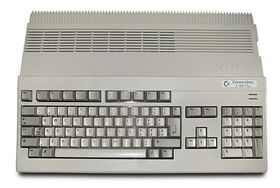Engineering:Amiga 500 Plus
 | |
| Type | Home computer |
|---|---|
| Release date | 1991 (UK), 1991 (Japan) |
| Discontinued | 1992 |
| Media | 880 KB floppy disks |
| Operating system | AmigaOS v2.04 |
| CPU | Motorola 68000 @ 7.16 MHz (NTSC) 7.09 MHz (PAL) |
| Memory | 1 MB (10 MB maximum) |
| Graphics | 640×256, 4 bpp @ 50 Hz (PAL) 640×200, 4 bpp @ 60 Hz (NTSC) |
| Sound | 4× 8-bit channels at max 28 kHz with 6-bit volume in stereo. |
| Predecessor | Amiga 500 |
| Successor | Amiga 600 |
The Commodore Amiga 500 Plus[1] (often A500 Plus or simply A500+) is an revised version of the original Amiga 500 computer. The A500+ featured minor changes to the motherboard to make it cheaper to produce than the original A500. It was notable for introducing new versions of Kickstart and Workbench, and for some minor improvements in the custom chips, known as the Enhanced Chip Set (or ECS).
Although officially introduced in 1992, some Amiga 500 units sold in late 1991 actually featured the revised motherboard used in the A500+. Although the Amiga 500+ was an improvement to the Amiga 500, it was minor. It was discontinued and replaced by the Amiga 600 in summer 1992, making it the shortest-lived Amiga model.
Compatibility problems
Due to the new Kickstart, quite a few popular games (such as Treasure Island Dizzy, SWIV, and Lotus Esprit Turbo Challenge) failed to work on the Amiga 500+, and some people took them back to dealers demanding an original Kickstart 1.3 Amiga 500. This problem was solved by third parties who produced Kickstart ROM switching boards, that could allow the Amiga 500+ to be downgraded to Kickstart 1.2 or 1.3. It also encouraged game developers to use better programming habits, which was important since Commodore already had plans for the introduction of the next-generation Amiga 1200 computer. A program, Relokick, was also released (and included with an issue of CU Amiga) which loaded a Kickstart 1.3 ROM image into memory and booted the machine into Kickstart 1.3, allowing incompatible software to run. In some cases, updated compatible versions of games were later released, such as budget versions of Lotus 1 and SWIV. Double Dragon 2 by Binary Design received an update for ECS machines with the "Amiga phase-alternated linescan version 4.01/ECS". This solved compatibility issues with the graphics which appeared garbled on ECS machines, and it also slashed the in-game loading times from around 20 seconds to just over 6.
Technical specifications
- Motorola 68000 CPU running at 7.09 MHz (PAL) / 7.16 MHz (NTSC), like its predecessor
- 1 MB of Chip RAM (very early versions came with 512 KB.)
- Kickstart 2.04 (v37.175)
- Workbench 37.67 (release 2.04)
- Built in battery backed RTC (Real Time Clock)
- Full ECS chipset including new version of the Agnus chip and Denise chip
See also
Footnotes

